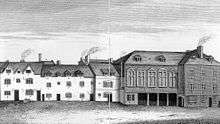John Dickens
| John Dickens | |
|---|---|
 | |
| Born | 21 August 1785 |
| Died | 31 March 1851 (aged 65) |
| Nationality | Great Britain |
| Known for | Father of novelist Charles Dickens. |
| Spouse(s) | Elizabeth Barrow |
| Children |
Frances Charles Letitia Harriet Frederick Alfred Augustus |
| Parent(s) |
William Dickens (father) Elizabeth Ball (mother) |
John Dickens (21 August 1785 – 31 March 1851) was the father of English novelist Charles Dickens and was the model for Mr Micawber in his son's semi-autobiographical novel David Copperfield.
Biography
The son of William Dickens (1719–1785) and Elizabeth Bal (1745–1824),[1] John Dickens was a clerk in the Royal Navy Pay Office at Portsmouth in Hampshire. On 13 June 1809 at St Mary le Strand, London, he married Elizabeth Barrow, with whom he had eight children. He was later transferred to London and then to Chatham, returning to live in Camden Town in London in 1822 to work in Somerset House. John Dickens found it difficult to provide for his growing family on his meagre income. Soon his debts had become so severe that all the household goods were sold in an attempt to pay his bills, including furniture and silverware.
Marshalsea Prison
Described by his son Charles as "a jovial opportunist with no money sense", unable to satisfy his creditors, on 20 February 1824 John Dickens was imprisoned in the Marshalsea Debtors' Prison under the Insolvent Debtors Act of 1813, because he owed a baker, James Kerr, £40 and 10 shillings.[2][3][4][5] In April 1824 his wife, Elizabeth, joined her husband in the Marshalsea with their four youngest children. John Dickens was released after three months, on 28 May 1824,[6] as a result of the death of his mother, Elizabeth Dickens, of the parish of St George, Hanover Square,[7] who had left him the sum of £450 in her will. On the expectation of this legacy, Dickens petitioned for, and was granted, release from prison. Under the Insolvent Debtors Act, Dickens arranged for payment of his creditors, and he and his family left Marshalsea for the home of Mrs. Roylance, with whom his 12-year-old son Charles was lodging.
Some years later John Dickens was again briefly imprisoned for debt, and was released only when his son Charles borrowed money from his friends based on the security of his salary. However, on his release from prison John Dickens immediately wrote begging letters to those same friends of his son also asking for money. He wrote to Thomas Beard claiming that his son Alfred "is walking to and from Hampstead daily in dancing Pumps".[8]
Later years

Later he became a journalist, and in 1828 a parliamentary reporter, like his famous son before him.[9] When Charles Dickens gained fame as a writer John Dickens frequently embarrassed his son by seeking loans from Charles's friends and publishers behind his back and by selling pages from his son's early manuscripts.[5] Concerned about his father's financial problems, Charles Dickens rented a cottage for his parents far from London, and, as he thought, far from temptation, at Alphington in Devon. However, John Dickens merely continued to write to Charles's friends and publishers asking for money. Eventually, he and his wife returned to London.
On 31 March 1851 John Dickens died of a urethral infection. According to a letter that Charles Dickens sent to his wife, John Dickens had been suffering from a bladder disease but had kept the condition secret until little could be done. After an operation, John Dickens lingered for several days before he died. The death certificate listed the cause of death as: "Rupture of the urethra from old standing stricture and consequent mortification of the scrotum from infiltration of urine." [10]
Dickens depicted his father in the character of Wilkins Micawber in his semi-autobiographical novel David Copperfield.[11][12]
John Dickens was buried in Highgate Cemetery, where in 1863 his remains were joined by those of his wife Elizabeth.
Children of John Dickens
- Frances (Fanny) Elizabeth Dickens (1810–1848)
- Charles John Huffam Dickens(1812-1870)
- Letitia Dickens (1816–1893)
- Harriet Dickens (1819–1824)
- Frederick Dickens (1820-1868)
- Alfred Lamert Dickens (1822-1860)
- Augustus Newnham Dickens(1827-1866)
See also
References
- ↑ Dickens Family Tree website
- ↑ Allingham, Philip V. (2004). "Where the Dickens: A Chronology of the Various Residences of Charles Dickens, 1812–1870", Victorian Web, 22 November 2004
- ↑ Darlington, Ida (1955) "Angel Place" "Southwark Prisons", Survey of London, Volume 25: St George's Fields (The parishes of St. George the Martyr Southwark and St. Mary Newington), pp. 9–21 says he was imprisoned for £10.
- ↑ "Why Dickens had a conscience" BBC News 3 December 2004
- 1 2 John Dickens on 'Charles Dickens: Family and Friends
- ↑ Allingham 2004
- ↑ London Metropolitan Archives, Saint George, Hanover Square: Hanover Square, Westminster, Transcript of Baptisms, Marriages and Burials, 1824 Jan-1824 Dec, DL/t Item, 089/019, DL/T/089/019
- ↑ Ackroyd, pg 160
- ↑ M. C. Rintoul 'Dictionary of Real People and Places in Fiction' Routledge, (1993) pg 362
- ↑ A. Welsh, Dickens Redressed: The Art of Bleak House and Hard Times (2000), p. 9
- ↑ W. Oddie, 'Mr. Micawber and the redefinition of experience' The Dickensian (1967) 63:109
- ↑ Charles Dickens Biography, Life, Books and his work on Literature
External links
- John Dickens on 'Charles Dickens:Family and Friends
- Dickens on Spartacus Educational
- Plaque to Dickens in Portsmouth's Historic Dockyard
